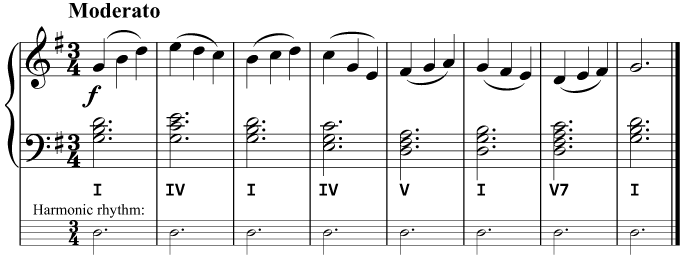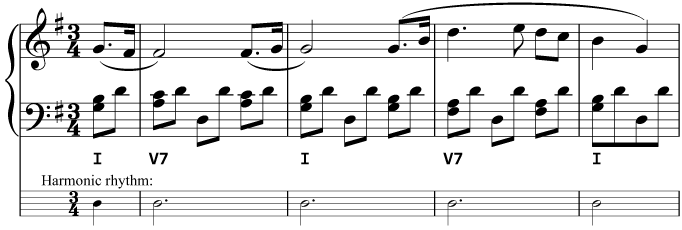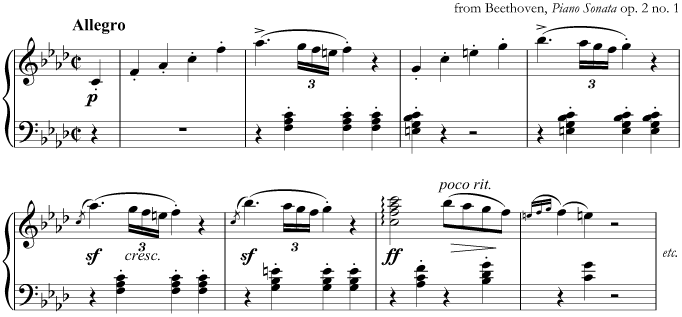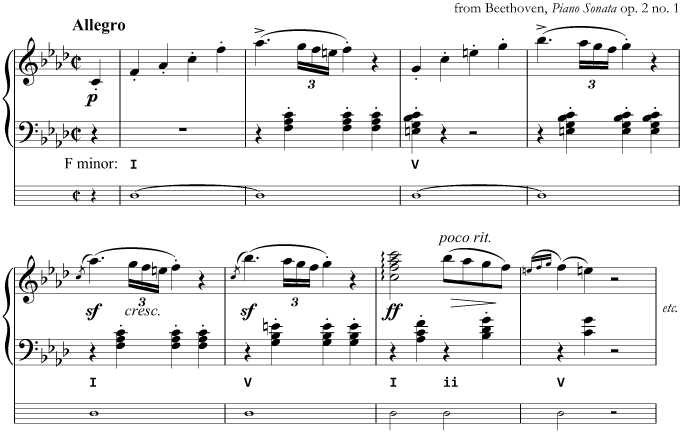Harmonic rhythm
In this guide...
Key terms:
Subscription required!
To view the complete study guide, you will need a valid subscription. Why not subscribe now?
Already have a subscription? Make sure you login first!
Introduction
We have now learnt a few things about harmony and a lot of things about rhythm. In this section we draw aspect of those two ideas together to take on harmonic rhythm.
Harmonic rhythm
As the name suggests, harmonic rhythm concerns the rate at which the harmony changes over the course of a piece of music.
The main difference between melodic rhythm (i.e., the rhythm of notes that you're already familiar with) and harmonic rhythm is that harmonic rhythm is typically much slower. While the notes of a melody can change every beat or even faster, the harmony could go several beats without changing.
Often the harmonic rhythm can be quite clear, such as when simple chords accompany a tune. In this example, the music has a melodic rhythm consisting of steady crotchets (i.e., the tune), whereas the harmonic rhythm consists of steady dotted minims (i.e., the chords):
 A simple example showing the difference between melodic and harmonic rhythm
A simple example showing the difference between melodic and harmonic rhythmRates of harmonic rhythm
If the harmonic rhythm is regular, then that means the chords (i.e. the harmony) change steadily at equal intervals of time. In the following example from Beethoven, for instance, the chords change one a bar (except for the upbeat!):
 Regular harmonic rhythm in music by Beethoven
Regular harmonic rhythm in music by BeethovenIrregular harmonic rhythm
However, as with melodic rhythm, perfectly regular changes are not rhythmically very interesting, and so composers will add variety. A harmonic rhythm that is not perfectly regular and unchanging is simply called irregular.
 Irregular harmonic rhythm in music by Mozart, in E flat major
Irregular harmonic rhythm in music by Mozart, in E flat majorAt the end of a phrase
A typical place in which composers will introduce irregularity to the harmonic rhythm is at the end of a piece of music, where an increase in frequency of harmonic change can provide a satisfying musical effect.
Consider the example below from the beginning of Beethoven's F minor Piano Sonata. Have a look through the passage and see if you can work out what the harmonies are, and where they change. It's helpful to write in the rhythm as shown in the previous examples.
 from Beethoven's Piano Sonata in F minor
from Beethoven's Piano Sonata in F minorHow did you do?
 from Beethoven's Piano Sonata in F minor, with harmonic rhythm indicated
from Beethoven's Piano Sonata in F minor, with harmonic rhythm indicatedCompare your findings with the solution below then think about how you might describe the harmonic rhythm of this passage.
How frequent are the changes in harmony at the beginning? And how frequent are the changes at the end?
The harmony changes once every two bars at the beginning of the phrase, then one a bar in bars 5 and 6, then once a minim for the final three chords, and is overall irregular.
This acceleration of harmonic rhythm is a very common technique used by composers to mirror an "acceleration" (or crescendo) in dynamics, as in the Beethoven example - from p at the beginning to ff at the end of the phrase.
A small hint
Look at the analysis of the harmonic rhythm in the Beethoven. As well as the harmonic rhythm and the Roman numerals for the harmoniy, we have also written in "F minor:" at the beginning.
This is a small but important addition: it makes clear that we believe the key to be F minor and therefore our I, V and other chord symbols are in relation to F minor and not some other key (for example, A flat major, which has the same key signature).
Read more...
With a subscription to Clements Theory you'll be able to read this and dozens of other study guides, along with thousands of practice questions and more! Why not subscribe now?